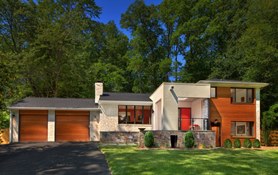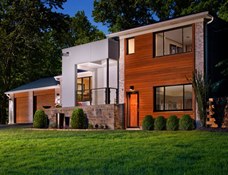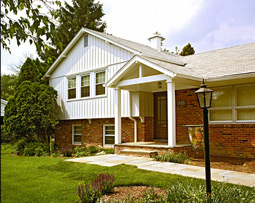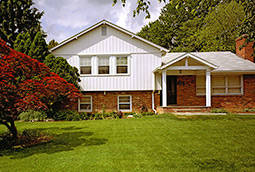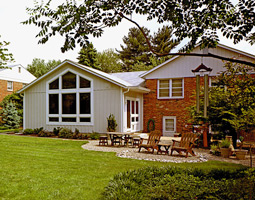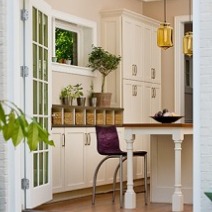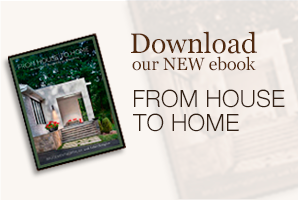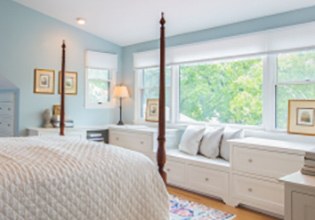Mid-century modern homes are finding new respect among homeowners in the Washington, DC, area. These homes are typically grouped into two categories — ranch and split-level — and date from 1935 to 1975. Among the most admired mid-century modern residential architects is Charles M. Goodman, whose home designs are found in Alexandria, Virginia (specifically Hollin Hills), and Silver Spring, Maryland (specifically Hammond Wood and Rock Creek Woods). Then, the much-loved homes in Bethesda, Maryland’s Carderock Springs historic district were designed by the architectural firm Keyes, Lethbridge & Condon, and developer Edmund Bennett.
Characteristics of Ranch-Style Mid-Century Modern Homes
Ranch houses originated in Southern California in the 1930s and 1940s, with architect Joseph Eichler providing many good examples on the West Coast. Ranch houses are built close to the ground and have a low-pitched hip or gable roof. This style was influenced by the Prairie style, which emerged in Chicago around 1900 from the work of a group of young architects, including the renowned Frank Lloyd Wright.
Attached garages are often integrated into the house design. The abundance of land led ranch-style houses to grow, resulting in the nickname “rambler.” As with many American design creations, the style is eclectic, perhaps more so than other home styles originating in the U.S. The appreciation for mid-century modern homes grew after World War II with the need to house returning war veterans who had growing families and tight budgets.
Characteristics of Split-Level Mid-Century Modern Homes
The unique floor plan within the mid-century modern architectural style is known as a split-level. It’s usually designed similarly to a ranch house but in a split-level configuration. Popular with home buyers in the 1950s, split-levels cost-effectively make efficient use of space.
Washington, DC-area homeowners acknowledge that they can get more for their money with this style. Split-level homes have three or more levels with partial flights of stairs linking each one. These houses are also referred to as bi-level or tri-level splits. The lower-level integrated garage or carport is a popular feature in many tri-level splits.
Materials
The exterior materials used to build these homes vary and are influenced by the geographic area. Stone or brick is a popular veneer, and in the Washington, DC, area, it is not unusual to see the local Carderock stone (a mix of gray and brownstone). Stucco and concrete block are found in some southern states, but these are seldom seen in the DC area. Wood is another common exterior material, installed horizontally as clapboard or vertically as board-and-batten siding.
Roof
Low-pitched hip roofs are the most common configuration for these homes, followed by a low-pitched gable roof. Dormers are not used in the style because there is minimal attic space. Roof overhangs are substantial, with exposed rafters on the more expensively designed homes. More modest ranch and split-level homes have minimal roof overhangs, either with an open eave or a closed eave soffit. Asphalt shingles are standard, and only rarely are metal or clay tiles used due to the high cost.
Windows
Ranch and split-level homes may have a wide variety of window types. To emphasize the close-to-the-ground design of the ranch-style, horizontal window designs are common. Awning, hopper, casement, and double-hung windows, each with horizontally configured panes, can be found. Picture windows are also a feature in most ranch or split-level homes. Picture windows are inoperable and are only installed to provide natural light and a view. Often, the horizontal design emphasis is repeated in picture windows.
Entrance
The recessed and protected front entry is a welcoming and practical feature of mid-century modern homes. The most complex designs feature a porch at the front of the house, tucked beneath the main roof, or an entrance at the intersection of two wings protected by the main roof. The recessed entry of a ranch or split-level home is often embellished with a different cladding material to signify its importance.
Wentworth has remodeled many DC-area homes, including those in the mid-century modern style. Visit our photo gallery to see some of our work for yourself!
Mid-Century Modern Design-Build Services in Washington, DC, MD & VA
Wentworth is proud to complete mid-century modern remodeling projects for homeowners in the Washington, DC, area. We specialize in incorporating all the unique elements that this design style offers, transforming any space into your favorite room in the house. The mid-century modern projects we can complete include:
- Mid-century modern home remodeling: Our clients often want to update the interior while preserving the original mid-century modern architecture. Others want to add a mid-century modern feel to a different home style. Whatever your goals, we can make it happen!
- Mid-century modern home additions: Branch out with an expanded kitchen, new primary suite, or additional bathroom to make your home more functional. Rest assured that one of our specialties is to build seamless additions while staying true to the original architecture.
- Mid-century modern interior reconfigurations: Is your home’s layout illogical or a waste of space? Enhance functionality, aesthetics, and resale value with a reconfigured interior in the mid-century modern style.
- Custom mid-century modern detailing: The Wentworth team has impressive attention to detail. Let us add mid-century modern characteristics — from wood-paneled vaulted ceilings to a centrally located fireplace to starburst light fixtures — all with the intent of helping you fall back in love with your home.
- Mid-century modern interior design services: Wentworth can meet your needs if you’re looking for a designer who understands the mid-century modern style. Our team can redesign your home with a brand-new interior inspired by the ingenious creations of Frank Lloyd Wright and other mid-century modern architects.
- Facade enhancements in the mid-century modern style: Your front entryway says a lot about you. We’ll help you create the recessed entry, low-pitched roof, and stone or brick facade characteristic of the mid-century modern style.
Check out photos of mid-century modern homes and other historic styles we specialize in. If you’re thinking of remodeling your mid-century modern home, follow these tips to make your project a success!
Frequently Asked Questions
What is the most common cause of damage to stone veneer?
Water intrusion is the most common cause of damage to stone veneers. When improperly sealed, water can slip beneath the thin surface, become trapped, and cause mold and wood rot. When this happens, it can severely damage the underlying studs and wood sheathing. It is essential to repair any underlying damage promptly and properly replace and seal the veneer.
Will replacing the windows on my mid-century modern home improve energy efficiency?
Window replacements are a highly effective solution for increasing energy efficiency. Further, replacing the windows can be done to enhance the home’s curb appeal with a modern touch architectural touch that will blend seamlessly with the original design.
Is it challenging to transform my mid-century modern home into a modern home?
It is not difficult at all. Indeed, the saying goes, “what’s old is new again.” Because mid-century modern and modern architecture share many of the same philosophies and design elements, updating the structure to fit more with current design tastes and trends is something our design teams can effectively achieve.
What are popular additions that add value to my home?
We can help you add value and comfort to your home. Some of the most popular home additions in the region include in-law suites, additional bedrooms, enhanced closets and bathrooms, sunrooms, finished basements, and the ever-popular, larger kitchen.
Can Wentworth’s designers match fabrics and tiles to my existing furniture?
Most certainly! Our interior design teams have a keen eye for detail and a broad network of suppliers. This allows us to match window treatments, wall coverings, paints, etc., to your current furniture and other elements you want to remain within the room.


